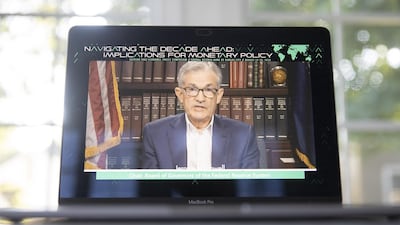Federal Reserve chairman Jerome Powell unveiled a new approach to setting US monetary policy, letting inflation and employment run higher in a shift that will likely keep interest rates low for years to come.
Following a more than year-long review, Mr Powell said the Fed will seek inflation that averages 2 per cent over time, a step that implies allowing for price pressures to overshoot after periods of weakness. It also adjusted its view of full employment to allow labour-market gains to reach more workers.
“Our revised statement emphasises that maximum employment is a broad-based and inclusive goal,” Mr Powell said Thursday in a speech delivered virtually for the central bank’s annual policy symposium, traditionally held in Jackson Hole, Wyoming.
“This change reflects our appreciation for the benefits of a strong labour market, particularly for many in low and moderate-income communities.”
During the longest US economic expansion on record until the pandemic hit earlier this year, many groups benefited – including minorities and women – in their ability to find work. With unrest breaking out across the US over racial inequality, questions about how the Fed’s policy helps communities broadly have been raised.
“They really, really, really are not going to be raising interest rates any time soon,” said James Knightley, chief international economist at ING Financial Markets. “The Fed is saying rates will be lower for longer, but don’t worry inflation is not going to be picking up.”
In its new statement on longer-run goals, the Fed said its decisions would be informed by its assessment of “shortfalls of employment from its maximum level.” The previous version had referred to “deviations from its maximum level.” The change de-emphasises previous concerns that low unemployment can cause excess inflation.
While expected, the announcement of the strategy shift came sooner than some thought. After first fluctuating on the news, US stocks resumed their record-breaking rally and the Treasury yield curve steepened to the widest in two months as traders bet policy rates will remain locked near zero for even longer.
Regarding price pressures, the document says the committee will target “inflation that averages 2 per cent over time” and will aim to bring inflation above the 2 per cent target following periods when inflation runs below that level.
Calling the revised strategy a “a robust updating,” Mr Powell spelled out that after periods when inflation has been running below 2 per cent, monetary policy will likely aim to achieve inflation moderately above 2 per cent for some time.
The shift he announced represents the product of an unprecedented review of the Fed’s strategies, tools and approach to communications that began in early 2019.
Since the central bank officially set its inflation target at 2 per cent in 2012, the Fed’s preferred measure of price increases has consistently fallen short of that objective, averaging just 1.4 per cent.
Low inflation contributes to low interest rates, reducing the Fed’s ability to fight off economic downturns and potentially making them deeper and longer. Mr Powell noted a risk, saying that “if excessive inflationary pressures were to build or inflation expectations were to ratchet above levels consistent with our goal”, the central bank wouldn’t hesitate to act.
Fed officials also altered the strategy document to include a section acknowledging that financial stability can also affect their ability to reach their longer-run goals.
“Sustainably achieving maximum employment and price stability depends on a stable financial system,” it said. “Therefore, the committee’s policy decisions reflect its longer-run goals, its medium-term outlook and its assessments of the balance of risks, including risks to the financial system that could impede the attainment of the committee’s goals.”

